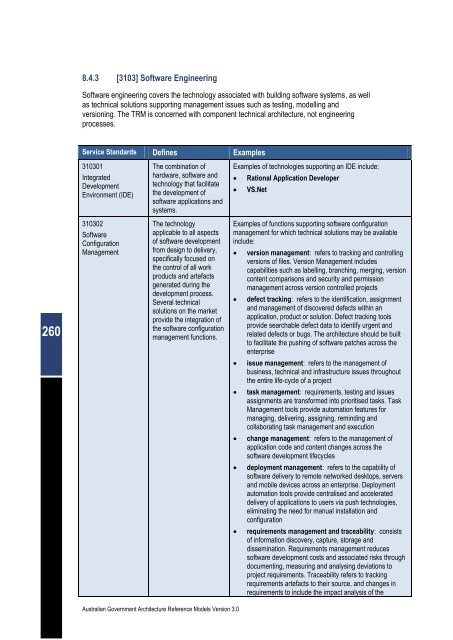Australian Government Architecture Reference Models Version 3.0
Australian Government Architecture Reference Models Version 3.0
Australian Government Architecture Reference Models Version 3.0
Create successful ePaper yourself
Turn your PDF publications into a flip-book with our unique Google optimized e-Paper software.
260<br />
8.4.3 [3103] Software Engineering<br />
Software engineering covers the technology associated with building software systems, as well<br />
as technical solutions supporting management issues such as testing, modelling and<br />
versioning. The TRM is concerned with component technical architecture, not engineering<br />
processes.<br />
Service Standards Defines Examples<br />
310301<br />
Integrated<br />
Development<br />
Environment (IDE)<br />
310302<br />
Software<br />
Configuration<br />
Management<br />
The combination of<br />
hardware, software and<br />
technology that facilitate<br />
the development of<br />
software applications and<br />
systems.<br />
The technology<br />
applicable to all aspects<br />
of software development<br />
from design to delivery,<br />
specifically focused on<br />
the control of all work<br />
products and artefacts<br />
generated during the<br />
development process.<br />
Several technical<br />
solutions on the market<br />
provide the integration of<br />
the software configuration<br />
management functions.<br />
<strong>Australian</strong> <strong>Government</strong> <strong>Architecture</strong> <strong>Reference</strong> <strong>Models</strong> <strong>Version</strong> <strong>3.0</strong><br />
Examples of technologies supporting an IDE include:<br />
� Rational Application Developer<br />
� VS.Net<br />
Examples of functions supporting software configuration<br />
management for which technical solutions may be available<br />
include:<br />
� version management: refers to tracking and controlling<br />
versions of files. <strong>Version</strong> Management includes<br />
capabilities such as labelling, branching, merging, version<br />
content comparisons and security and permission<br />
management across version controlled projects<br />
� defect tracking: refers to the identification, assignment<br />
and management of discovered defects within an<br />
application, product or solution. Defect tracking tools<br />
provide searchable defect data to identify urgent and<br />
related defects or bugs. The architecture should be built<br />
to facilitate the pushing of software patches across the<br />
enterprise<br />
� issue management: refers to the management of<br />
business, technical and infrastructure issues throughout<br />
the entire life-cycle of a project<br />
� task management: requirements, testing and issues<br />
assignments are transformed into prioritised tasks. Task<br />
Management tools provide automation features for<br />
managing, delivering, assigning, reminding and<br />
collaborating task management and execution<br />
� change management: refers to the management of<br />
application code and content changes across the<br />
software development lifecycles<br />
� deployment management: refers to the capability of<br />
software delivery to remote networked desktops, servers<br />
and mobile devices across an enterprise. Deployment<br />
automation tools provide centralised and accelerated<br />
delivery of applications to users via push technologies,<br />
eliminating the need for manual installation and<br />
configuration<br />
� requirements management and traceability: consists<br />
of information discovery, capture, storage and<br />
dissemination. Requirements management reduces<br />
software development costs and associated risks through<br />
documenting, measuring and analysing deviations to<br />
project requirements. Traceability refers to tracking<br />
requirements artefacts to their source, and changes in<br />
requirements to include the impact analysis of the

















